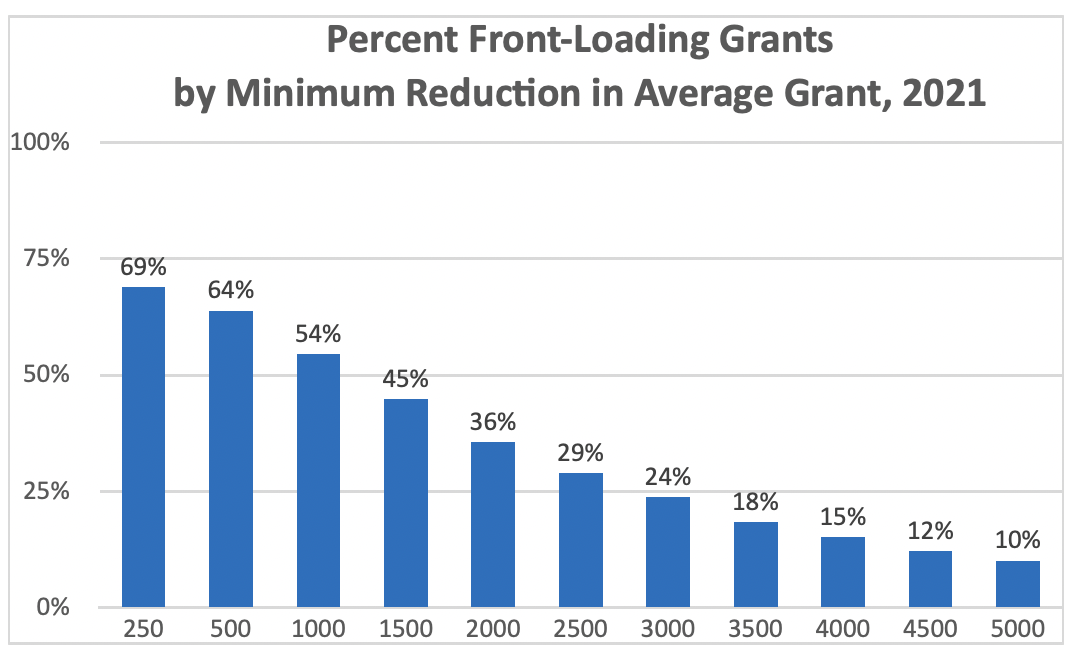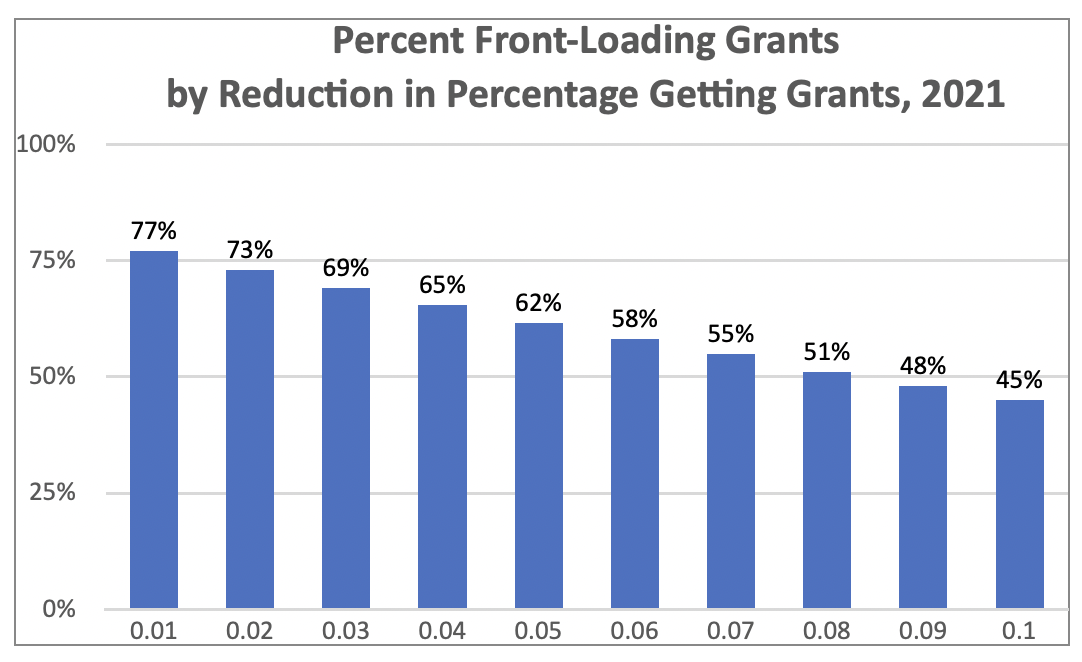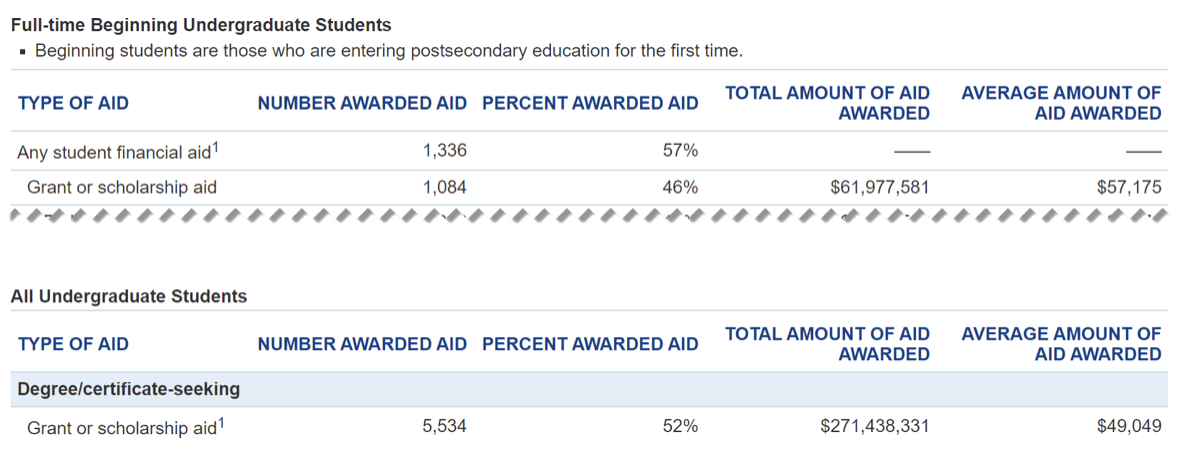
Entrance-loading of monetary support like grants and scholarships is a type of bait-and-switch, the place a university provides a greater monetary support supply to freshmen than to sophomores, juniors and seniors.
When a university practices front-loading of monetary support, the common grant per recipient decreases after the primary 12 months and/or the proportion of scholars receiving grants decreases.
This implies college students get smaller grants and/or fewer college students get grants. Even when a university retains the grants unchanged, the web value will enhance as school prices enhance.
Entrance-loading of grants causes the combination of grants vs. loans to turn into much less favorable after the freshman 12 months. The household’s share of school prices will increase considerably for upperclassmen, even when their capability to pay for faculty stays unchanged.
Statistics Regarding Entrance-Loading of Grants
Greater than four-fifths of faculties apply front-loading of grants, based mostly on an evaluation of information from the 2021 Built-in Postsecondary Training Knowledge System (IPEDS). IPEDS knowledge is offered by the universities and is printed by the Nationwide Middle for Training Statistics (NCES) on the U.S. Division of Training.
IPEDS knowledge gives two units of statistics, one for full-time first-time undergraduate college students (i.e., freshmen) and one for all undergraduate college students. These statistics embrace:
- The variety of college students awarded federal, state, native, institutional or different sources of grant support
- The overall quantity of federal, state, native, institutional or different sources of grant support awarded
- The overall variety of college students
One can subtract the figures for full-time first-time undergraduate college students from the figures for all undergraduate college students to calculate the figures for upperclassmen.
The ratio of the variety of college students awarded grants to the entire variety of college students yields the proportion of scholars receiving grants.
The ratio of the entire quantity of grants to the variety of college students awarded grants yields the common grant per recipient.
Greater than half (54%) of 4-year schools scale back the common grant by at the least $1,000. Greater than three-fifths (62%) of 4-year schools scale back the proportion receiving grants of at the least 5% share factors. Greater than four-fifths (82%) of 4-year schools fulfill both or each of those definitions.
Public schools usually tend to apply front-loading of grants. Amongst public 4-year schools, 88% fulfill both or each of those thresholds. Amongst personal non-profit 4-year schools, 80%. Amongst personal for-profit 4-year schools, 75%.
Essentially the most selective schools are much less doubtless than much less selective schools to apply front-loading of grants, though it’s nonetheless a excessive share. Amongst 4-year schools that admit lower than 40% of candidates, 70% fulfill both or each of those thresholds. Amongst 4-year schools that admit greater than 40% of candidates, 83% fulfill both or each of those thresholds.
This chart exhibits the proportion of 4-year schools lowering common grants by at the least every particular greenback quantity.

This chart exhibits the proportion of 4-year schools lowering the proportion of scholars receiving grants by at the least a selected share level.

MIT, Swarthmore, Amherst, Bowdoin, Tulane, Harvey Mudd, UCLA, Georgetown, USC, Carnegie Mellon College, UC Berkeley, College of Michigan at Ann Arbor and UNC Chapel Hill don’t apply front-loading of grants. For instance, at MIT there isn’t any change within the share receiving grants, and the common grant will increase by about $2,000 for upperclassmen.
Among the many Ivy League schools, solely Princeton and Cornell don’t apply front-loading of grants. The others all apply front-loading of grants.
One Ivy League establishment, who shall stay unnamed, has a 16% share level discount within the share of scholars receiving grants, and the common grant decreases by about $12,500 for upperclassmen. This identical school has one of many lowest commencement charges among the many Ivy League schools.
Learn how to Inform If a Faculty Practices Entrance-Loading of Grants
You possibly can’t use a university’s web value calculator to find out whether or not a university practices front-loading of grants, since web value calculators are restricted to only the freshman 12 months in school.
As an alternative, you need to use the U.S. Division of Training’s Faculty Navigator software to find out whether or not a university practices front-loading of grants.
Seek for the identify of the school, then click on on the Monetary Help tab within the search outcomes. There can be two units of numbers, labeled Full-time Starting Undergraduate College students and All Undergraduate College students. Have a look at the % Awarded Help and Common Quantity of Help Awarded columns for the Grant or scholarship support rows. Slightly arithmetic will yield the common grant for upperclassmen for comparability with the determine for freshmen.
For instance, take into account a university with the next figures proven in Faculty Navigator. Subtract the Complete Quantity of Help Awarded and Quantity Awarded Help for Full-Time Starting Undergraduate College students from All Undergraduate College students, yielding $209,460,750 and 4,450. Divide the latter into the previous, yielding an Common Quantity of Help Awarded of $47,070 for upperclassmen. That’s greater than $10,000 decrease than the common grant support for freshmen. This school clearly practices front-loading of grants.

Observe that you just don’t have to do the maths to inform that the common grant awarded to freshmen is larger than the common grant awarded to all undergraduate college students. It’s much less exact than calculating the figures for upperclassmen, however it nonetheless exhibits that the school practices front-loading of grants.
Affect of Entrance-Loading on Outcomes
Entrance-loading of grants could have an preliminary optimistic influence on school enrollment, for the reason that grants make school appear to be extra inexpensive. Entrance-loading of grants helps schools recruit extra college students.
However, school retention could fall because of elevated prices after the primary 12 months. The elevated prices will disrupt the coed’s tutorial progress, as they’re pressured to seek out different methods to cowl the school prices. They could, for instance, must work longer hours to earn more cash to pay for faculty. However, college students who work a full-time job are half as more likely to graduate inside six years as in contrast with college students who work 12 hours or much less per week.
They could additionally must borrow extra, rising scholar mortgage debt at commencement.
The rise within the web value can have a adverse influence on school commencement charges. Extra college students will drop out once they can’t afford to pay the school payments or when working longer hours takes an excessive amount of time away from lecturers.
Entrance-loading of grants has a adverse influence on switch college students, who obtain much less support than college students who began as freshmen.
Schools Can’t Justify Entrance-Loading of Grants
Entrance-loading of grants can’t be defined by modifications in household monetary circumstances. Though some college students could qualify for much less monetary support due to elevated household earnings, most college students expertise flat household earnings. General, modifications in household earnings don’t clarify the lower in common grants, nor do they clarify the shift from grants to loans.
Likewise, front-loading of grants can’t be defined by non-renewable scholarships, as the web influence is comparatively small, particularly when one considers the influence of scholarship displacement. Additionally, unmet want exceeds $10,000 on common nationwide.
Some schools argue {that a} very excessive share of their enrollment comes from switch college students, and they’re much less beneficiant to switch college students. Which may be true, however that’s hardly one thing to be happy with. Solely 4% of 4-year schools have greater than 1 / 4 of their undergraduate enrollment from switch college students.
The publish Entrance-Loading Monetary Help: Watch Out For This Sneaky Trick appeared first on The Faculty Investor.








